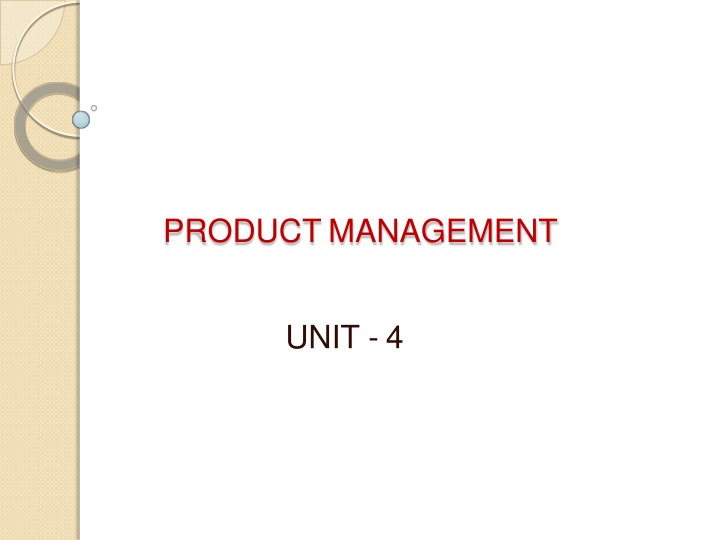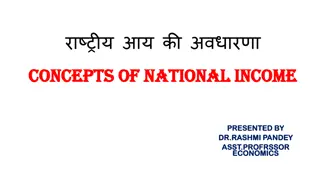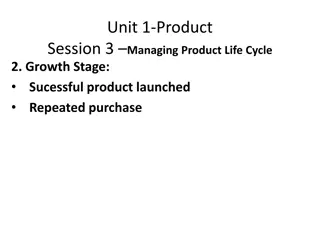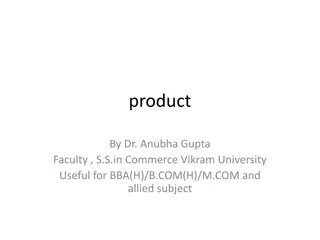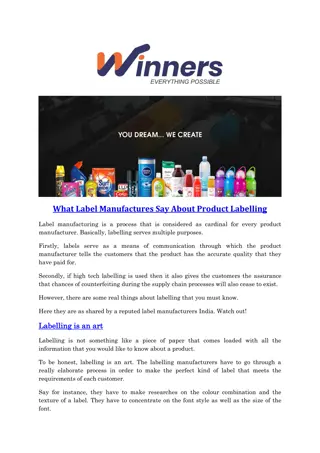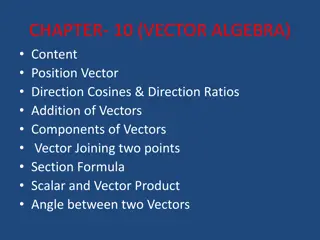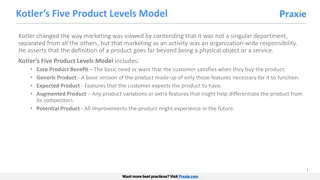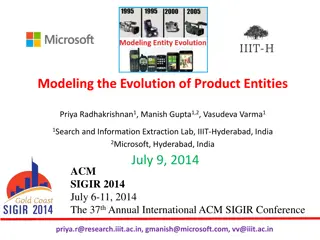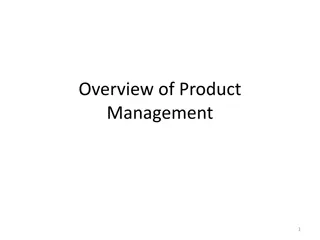PRODUCT MANAGEMENT
The concept of product management is crucial in marketing, as a product can be anything offered to a market for attention, acquisition, use, or consumption. Products can include physical objects, services, personalities, places, organizations, and ideas. Product management involves decision-making on profit and wealth maximization, shaping product images, and considering consumer and company perspectives. Various perspectives on products, such as economic, technical, and consumer points of view, highlight the importance of understanding and meeting customer needs and desires. Product planning involves evaluating ideas, resources, and customer specifications, developing and testing products, and marketing them effectively to create a successful outcome.
Download Presentation

Please find below an Image/Link to download the presentation.
The content on the website is provided AS IS for your information and personal use only. It may not be sold, licensed, or shared on other websites without obtaining consent from the author.If you encounter any issues during the download, it is possible that the publisher has removed the file from their server.
You are allowed to download the files provided on this website for personal or commercial use, subject to the condition that they are used lawfully. All files are the property of their respective owners.
The content on the website is provided AS IS for your information and personal use only. It may not be sold, licensed, or shared on other websites without obtaining consent from the author.
E N D
Presentation Transcript
PRODUCT MANAGEMENT UNIT - 4
CONCEPT OF APRODUCT: Acc. to PHILIP KOTLER A product is anything that can be offered to a market for attention, acquisition, use or consumption. It includes physical objects, services, personalities, places, organizations and ideas. Product occupies a dominant position in marketing mix {one of the 4 p s} Key element of the marketing programme. Before making decisions about pricing, promotion, distribution firm has to decide about the product.
Product have two aims: 1. Profit maximization 2.Wealth maximization [customer satisfaction] Product policies decision from an important basis for the firms competitive advantages in the market place. Consumers perceives the product from different angels. This perception are to be combined in the form of product image.
Consumer point of view Company point of view Need Product Want Product image Price Promotion Personality Prestige Income Place Education
VARIOUS USE OF APRODUCT: I general view, product is defined as everything the purchaser gets in exchange of money is a product. TECHNICAL / MANUFACTURING POINT OF VIEW: A product consists of various of raw materials put together so, that the end result serves a useful purpose of consumption. ECONOMIC POINT OF VIEW: A product consists of a bundle of utilities [value] involve in various product features and accompanying services.
FROM THE CONSUMERS POINT OF VIEW: What a desire are not the product but satisfying the experiences. DEFINITION: A product is a complex of tangible, intangibleand external attributes including functional, social and psychological utilities or benefits . A product has as bundle of physical services and a symbolic attributes expected to yield satisfaction or benefits to the buyers. This concept has actually led to defining the product as the total product.
PRODUCT PLANNING: Product planning has been defined by American Marketin Association as The act of marketing out & supervising the search, screening, development and communication of ne Products, the modification of existing lines and the Discontinuous of marginal or unprofitable items. STEPS/ PROCESS: 1) Evaluation of the idea, market & the product 2) Evaluation of company resources 3) Finding out customer specifications 4) Developing the product 5) Testing the product 6) Marketing the product 7) Evaluating the result {feedback}
SIGNIFICANCE OF PRODUCT PLANNING {IMPORTANCE} IF YOU FAILTO PLAN, YOU RE PLANNING TO FAIL 1) Basis of marketing programme 2) For survival 3) To face competition 4) To minimize risk 5) Instrument of growth 6) To discharge social responsibilities
PRODUCT OBJECTIVES & STRATEGIES: 1) Product policy Product mix Product item Product line 2) Elements of product policy Product planning & development Product line Product standardization Product identification {branding} Product style Product packaging
PRODUCT MIX Product mix Product Breadth Product depth Product consistency
FACTORS INFLUENCING PRODUCT MIX: 1) Population increase 2) Changes in level of the income of the buyers 3) Changes in consumer behaviour 4) Other reasons Marketing influences {competition, place, media} Product influences Financial influences
NEW PRODUCT DEVELOPMENT: {V.V.IMP} Product planning deals with changes in: 1) The kinds of goods or services offered 2) The number/kinds of products or different lines that the company offers 3) The width of assortment within each product line offered 4) The quality levels/ levels acceptable to various classes of customers 5) The degree of distinctiveness [different]
The following are the basic changes that may be required in product planning: 1) Improving the existing products 2) Weeding [unprofitable items] out profitable of the product line 3) Expansion of the current product line [diversification]s 4) New product development for the present customers 5) New product for new customers
NEW PRODUCT DEVELOPMENT STAGES: 1) EXPLORATION OF IDEAS / IDEAGENERATION: R&D Distributors Competitors Customers Employees Professional investment/ marketing agencies 2) SCREENING OF IDEAS: Expanding each idea into full product concept Collecting facts & opinion to decide whether the product idea could be converted into a business proposition Technology Assessing each idea for its potential value for its company
3) BUSINESSANALYSIS: Future study on each idea in detail Determining the desirable market features for the product & its feasibility Developing specification & establishing a definate programme for the product 4) DEVELOPING THE PRODUCT: Idea on the paper is turned into product on a hand. 5) TESTING: Concept testing Product testing Test marketing
a) CONCEPT TESTING: To evaluate the relative merits of several new product proposals To determine whether the product idea is to be abounded or modified To determine the size of potential market To guide the management to adopt suitable policies b) PRODUCT TESTING: To assess proper product performance To minimise the risk attached to full scale launching of a new product To identify the most productive market segments To collect necessary data of responsiveness from the customers
c) TEST MARKETING: To evaluate a complete marketing plan including advertisement, distribution, sales, pricing etc To determine media mix, channels e.t.c To forecast sales volume 6) COMMERCIALISATION: Completing final plans for production & marketing Initiating, co-ordinated production & selling programmes Checking results at regular intervals
WHY NEW PRODUCTS FAIL IN THE MARKET ??? REASONS: Inadequate market analysis Product defect Higher cost Poor timing [proper] Competition Insufficient marketing effort Inadequate sales force Weakness in distribution
*** v.imp PRODUCT LIFE CYCLE [PLC]: There are 4 stages of product life cycle. I. Introduction II. Growth III. Maturity IV. Decline Introduction Growth Maturity Decline Sales / Profit volume bep TIME
Products have a limited life Products sales pass through different stages each posing different challenges, opportunities & problems to the seller Profits rise & fall at different stages of PLC Products require different marketing, financial, manufacturing, purchasing, human resources strategies in each stage of the PLC DEFINITION: Acc. To PHILIP KOTLER The product life cycle is an attempt to recognise distinct stages in sales history of the product. PLC concerns with the study of degree of product acceptance by the market overtime. It includes major raises & falls of sales during its life.
PLC STAGES: I. INTRODUCTION STAGE: Huge selling & promotion cost are required to increase awareness of the customers. Price is kept high to recover high development, production & marketing cost Marketer has to tackle technical and production problems Sales are low and increasing at a lower rate. There is loss or negligible profit There is no competition.
II. GROWTH STAGE: Sales increase rapidly as a result of consumer acceptance of the products. Company can earn maximum profits. Competitors enter the market due to attractive profits Price is reduced to attract more customers Distribution network is widened and improved Necessary primary changes are made in products to remove defects Company enters the new segments and channels are selected.
III. MATURITY STAGE: a) Growth maturity b) Stable maturity c) Decline maturity Sales increase at decreasing rate Profits starts declining Marginal competitors leave the market Customer retention is given more emphasis Product, market & marketing mix modifications are undertaken.
IV. DECLINE STAGE : Sales fall rapidly Profits fall more rapidly than sales Product modification is adopted Gradually, company prefers to shift resources to new products. Most of the sellers withdraw from the market Promotional expenses are reduced to realise a little profit.
BRANDING, PACKAGING, LABELLING [BPL] STRATEGIES: I. BRANDING: A brand is a name, term, symbol or design or a combination of them which is intended to identify the goods or services of one seller or a group of sellers and to differentiate them from those of competitors Brand name Brand mark Trade mark Branding Trade name Patents Copy rights
FUNCTIONS OF BRANDING: Branding helps in product identification & distinctiveness to a product Indirectly it denotes the quality or a standard of a product. It eliminates imitation products. It ensures legal rights on the product. It helps in advertising and packaging activities. It helps to create and sustain brand loyalty to particular products. It helps in price differentiation of products.
CLASSIFICATION OF BRANDS: I. National Regional Advertising brands Single brands Multiple brands Individual brands Manufacturer s brands : II. DISTRIBUTER S BRANDS: Private brand Store brand Dealer brand House brand
KINDS OF BRANDS: 1. Coined name e.g: parker pen 2. Arbitrary name { not related to product } 3. Suggestive name e.g : boost 4. Descriptive name e.g : glucose D CHARECTERISTICS OF A BRAND NAME: Easy Read and understand Remember Appropriate It should be descriptive name
II. PACKAGING: FUNCTIONS OF PACKAGING: Two assemble and arrange the products in the desired form To identify the contents the brand and the maker [ product differentiation is perfected to the function] To protect the contents from product line through final use/ consumption To provide a suitable product mix [ size, weight, grade, package] To facilitate retailer s functions To facilitate transportation, storing, warehouse, handling To enable the display of contents To encourage repurchase To help in complying with legal requirements To provide opportunity and space for advertising.
KINDS OF PACKAGING: 1. Family packaging same for all products 2. Reuse packaging e.g: soap case, hand wash 3. Multi packaging: More than 1 product is packed e.g: tooth paste & brush, natraj pencil with sharpener and eraser.
PROBLEMS IN PACKAGING: 1. High cost of production/packaging 2. Appearance 3. Kinds of designs 4. Convenience 5. Reuse purpose 6. AIDA [ Attention, Interest, Desire,Action]
III. LABELLING: Label is a small slip placed on or near anything [product] to denote its nature, contents, ownership, destination etc . FUNCTIONS: 1. It gives definiteness to a product & therefore the identification of a product is easy. 2. It stresses the standard & other special features of the product 3. It enables the manufacturer to give clear instructions to the consumer about use of the product 4. By mentioning prices undue price variations caused by the intermediaries are avoided 5. It encourages to produce only standardized & quality products 6. It provides a method for manufactures by which a contact
KINDS OF LABELS: 1. Brand labels e. g: cosmetics, sweets, chocolates etc 2. Grade labels e. g: clothes [silk] 3. Descriptive labels [ uses of product] e. g: milk food 4. Informative labels e. g: medicines
ADVANTAGES OF LABELLING : 1. Social service 2. Avoids price variations 3. Helps advertising 4. It helps to assess the superiority of a product 5. It is a guarantee for the standard of a product DISADVANTAGES : 1. No use for illiterate people 2. Increase cost of a product 3. It is effective only where standardization is compulsory 4. Comparison ultimately ends in discarding one product in favour of other.
